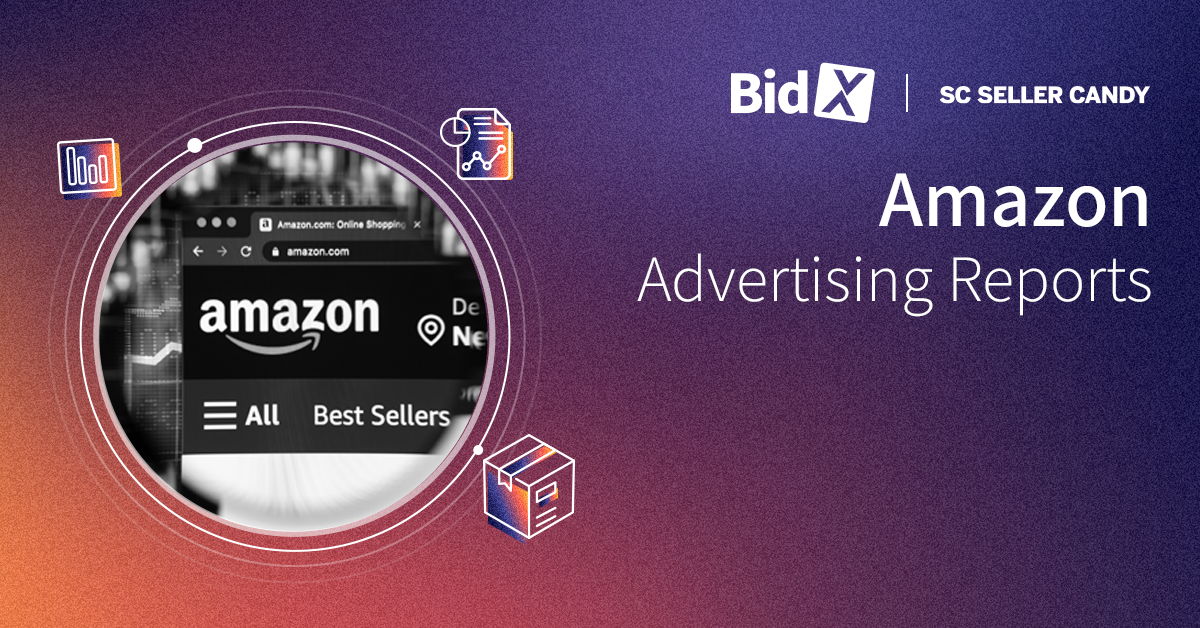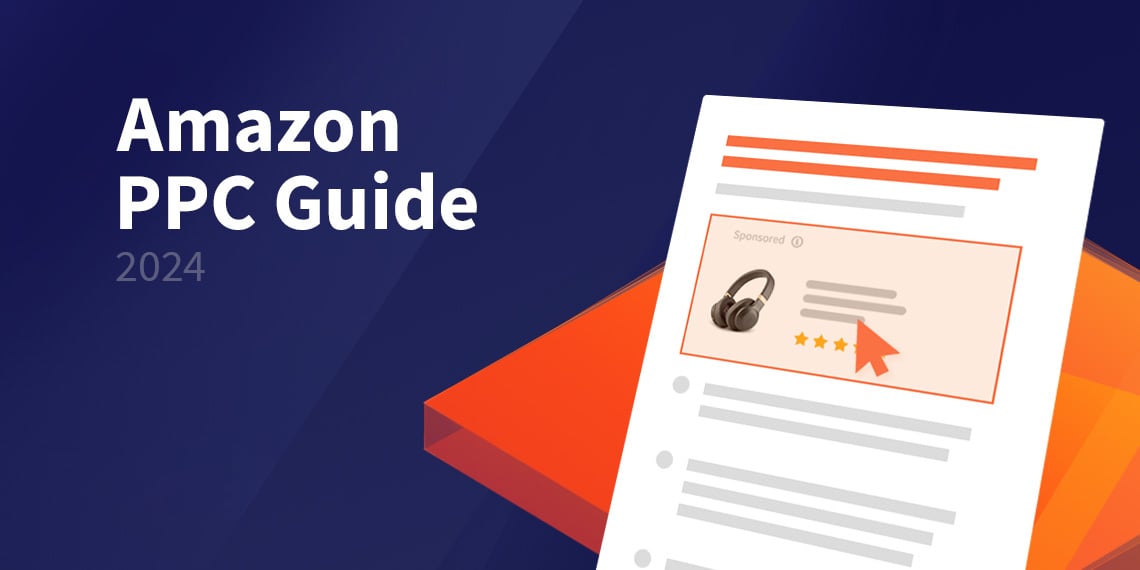Amazon Advertising Reports: How to Interpret And Use Them
As an Amazon seller, running PPC (Pay-Per-Click) campaigns for your products is crucial. But launching the campaign is just the beginning. You've chosen keywords and set your ad budget, but how do you know if it's working?
This is where Amazon's advertising reports come into play. Think of them as your campaign's roadmap. They show what's working and what's not. With this info, you can improve your campaigns, spend your budget wisely, and make your Amazon campaigns successful.
Let's dive into the different types of Amazon advertising reports and how they can help you.
What Are Amazon Advertising Reports?
Amazon advertising reports provide detailed insights into your ad campaign's performance. They help you refine your marketing strategy, ensuring each product reaches its potential by guiding your ad campaigns to success.
Amazon Advertising Report Types

Amazon offers a variety of PPC reports for Sponsored Products, Sponsored Brands, Sponsored Brand Videos, and Sponsored Display ad campaigns. Each report delivers specific metrics to assist you in making informed business choices.
Sponsored Products Reports
Amazon produces various reports for sponsored products, including:
- Search Term Report: Shows what search terms or competitor ASINs led customers to your products. Includes sales, ACoS, RoAS, and more.
- Targeting Report: Data on how well your keywords, products, or categories are doing.
- Advertised Product Report: Metrics for your advertised products that got views.
- Campaign Report: Overview of your Sponsored Products ad performance.
- Placement Report: How ads perform in different places, like the top of search or on product pages.
- Purchased Product Report: Info on products bought through your ads that weren’t directly advertised.
- Performance Over Time Report: Clicks, CPC, and spend over time.
- Search Term Impression Share Report: How your ads compare to others in terms of visibility.
Sponsored Brand Bericht
Amazon offers several reports for sponsored brands, detailed as follows:
- Keyword Report: Details on search terms leading to your products, including sales, ACoS, and more.
- Keyword Placement Report: Data on where your ads are placed.
- Campaign Report: Overview of campaign success.
- Campaign Placement Report: Information on ad locations and buyer interactions.
- Search Term Report: Data on search terms, similar to the keyword report.
- Search Term Impression Share Report: How your ads compare to competitors.
- Category Benchmark Report: Compares your brand’s performance to others in your category.
Sponsored Brand Video Reports
For sponsored brand videos, Amazon produces four specific reports:
- Keyword Report
- Campaign Report
- Campaign Placement Report
- Search Term Report
An SBV (Sponsored Brand Video) campaign falls under the Sponsored Brands category. Therefore, each report offers information identical to what was previously outlined in the "Sponsored Brands" section.
Sponsored Display Bericht
For Sponsored Display, Amazon offers four distinct reports:
- Campaign Report: General performance of your Sponsored Display campaigns.
- Targeting Report: Tracks how well did your targeted audience respond.
- Advertised Product Report: Sales and performance of advertised products.
- Purchased Product Report: Info on non-advertised products bought after clicking your ad.
Key Amazon Advertising Reports and How to Interpret Them

Although Amazon offers a variety of reports for each type of campaign, not all of them carry the same weight. Many marketers focus on Search Term reports, Targeting reports, and Advertised Product reports for refining their Amazon PPC strategies.
So, let’s dive into the various PPC Reports and explore how to utilize them effectively:
Search Term Reports
Sellers widely use and review Amazon Search Term Reports for PPC insights.
These reports provide a detailed view of the exact search terms that Amazon customers use to discover and buy your products, as well as those of your competitors.
Metrics included in the Search Term Report:
- Start and End Dates of the Campaign
- Portfolio Name
- Name of the Campaign
- Name of the Ad Group
- Targeting (Specific Keyword Targeted)
- Type of Match
- Customer Search Term
- Number of Impressions
- Clicks and Click-Through Rate (CTR)
- Cost Per Click (CPC)
- Total Spend
- Sales in 7 Days
- Total Advertising Cost of Sales (ACoS)
- Total Return on Advertising Spend (RoAS)
When your PPC campaigns run for over two weeks, regularly review your reports to discover effective new keywords. Focus on the Search Term Report and examine the Advertising Cost of Sales (ACoS) to identify high and low performing keywords. Stop using money on the low performers by labeling them as negatives in your campaign.
If a keyword with a broad match has a small ACoS, change it to a phrase match. And if that phrase match still has a small ACoS, switch it to an exact match. This strategy sharpens your targeting and reduces unnecessary spending.
Also, watch your automatic campaigns closely. If you spot search terms that do well, move them to manual exact campaigns. This step gives you better control and can boost your ad earnings.
Targeting Report
The Sponsored Product campaigns targeting report provides an in-depth analysis of the effectiveness of various targeting methods used in your campaigns over the last 90 days.
This report details every keyword, ASIN, and category you've targeted in your advertising efforts. It also outlines the performance across different match types in auto-campaigns.
Key metrics included in the targeting report:
- Date
- Portfolio Name
- Campaign Name
- Ad Group Name
- Targeting
- Match Type
- Impressions
- Clicks
- Click-Through Rate (CTR)
- Cost Per Click (CPC)
- Spend
- Total Advertising Cost of Sales (ACoS)
- Total Return on Advertising Spend (RoAS)
- 7-Day Total Sales
- 7-Day Total Orders (#)
The targeting report shows how well your keywords and products are doing. You can adjust your bids, spot duplicate keywords, and spend your ad budget smartly.
If a keyword gets many clicks but few views, raise your bid to reach more customers and increase sales. If products have a 0% ACoS, meaning they get clicks without sales, improve your listing or stop using those keywords to save money.
Also, you can discover sales trends by looking at which products sold well in the last 90 days.
Advertised Product Report
The Advertised Product Report gives you detailed information on how well your advertised products (ASINs) are doing in all your campaigns, as long as they've been seen at least once.
It also separates the performance details of each ASIN by campaign, ad group, and SKU.
Metrics found in the advertised product report:
- Start Date/End Date
- Portfolio Name
- Campaign Name
- Ad Group Name
- Advertised SKU
- Advertised ASIN
- Impressions
- Clicks
- Click-Through Rate (CTR)
- Cost Per Click (CPC)
- Spend
- 7-Day Total Sales
- Total Advertising Cost of Sales (ACoS)
- Total Return on Advertising Spend (RoAS)
- 7-Day Total Orders (#)
Organize the report by 7-Day Total Sales to find out which products are selling the best.
For instance, if you're planning your Prime Day advertising, you might want to put more money into ads for products that are making the most profit. The 7-Day Total Sales number helps you quickly see which products are popular so you can focus your ad budget on them.
Placement Report
Your bid affects where your Sponsored Products and Sponsored Brands ads appear, like the top of search results. The placement report shows ad performance by location.
It reveals the best spots for your ads by tracking impressions, ACoS, and sales. Use this data to adjust bids and boost campaign earnings.
Metrics in the placement report include:
- Date
- Portfolio Name
- Currency
- Campaign Name
- Bidding Strategy
- Placement
- Impressions
- Clicks
- Cost Per Click (CPC)
- Spend
- 7-Day Total Sales
- Total Advertising Cost of Sales (ACOS)
- Total Return on Advertising Spend (ROAS)
- 7-Day Total Orders (#)
Budget Report
The Sponsored Products Budget Report is a tool that improves how you handle your ad campaigns.
It gives you data to see what could happen to your sales and income if your campaigns run out of money.
Plus, it offers tips to help prevent your budget from running dry.
Metrics in the budget report include:
- 7-Day Total Orders (#)
- 7-Day Total Sales
- Average Time in Budget
- Bidding Strategy
- Budget
- Campaign Name
- Campaign Type
- Clicks
- Click-Through Rate (CTR)
- Cost Per Click (CPC)
- Currency
- End Date
- Estimated Missed Clicks Range Max
- Estimated Missed Clicks Range Min
- Estimated Missed Impressions Range, Max
- Estimated Missed Impressions Range Min
- Estimated Missed Sales Range Max
- Estimated Missed Sales Range Min
- Impressions
- Portfolio Name
- Recommended Budget
- Spend
- Start Date
- Status
- Total Advertising Cost of Sales (ACOS)
- Total Return on Advertising Spend (ROAS)
Purchased Product Report
Sometimes, after clicking on an ad for one product, shoppers end up buying a different product from your line-up.
The Purchased Product Report tells you which product they bought instead of the one in the ad. This is useful for figuring out how to lower your ACoS and find chances to sell more products together or more expensive products.
This report can help you decide if you should advertise these other products too.
Metrics in the purchased product report include:
- Start Date
- End Date
- Currency
- Campaign Name
- Portfolio Name
- Cost Type
- Ad Group Name
- Bid Optimization
- Advertised SKU
- Advertised ASIN
- Purchased ASIN
- 14-Day Brand Halo ASIN Orders (#)
- 14-Day Brand Halo ASIN Units (#)
- 14-Day Brand Halo ASIN Sales ($)
Gross and Invalid Traffic Report
Sometimes, your product listings might get clicks but no sales. This could be because of fake or bot traffic.
The Gross and Invalid Traffic Report helps identify traffic that might not be real. This includes things like repeated clicks or visits that don’t help your sales and can mess up your data.
You can use this report to see overall traffic details for your campaign, such as total and invalid impressions and clicks.
Metrics in the Gross and Invalid Traffic Report are:
- Campaign Name
- Clicks
- End Date
- Gross Clicks
- Gross Impressions
- Impressions
- Invalid Click Rate
- Invalid Clicks
- Invalid Impression Rate
- Invalid Impressions
- Start Date
- Status
Compare this report with your campaign’s performance metrics like CTR (Click-Through Rate) and CVR (Conversion Rate) to check the quality of your traffic.
If invalid traffic goes down but CTR and CVR are high, it means your campaign is attracting genuinely interested users, and vice versa.
Performance Over Time Report
This report tracks clicks, cost per click (CPC), and total spend on Sponsored Product ads over time. But, it doesn't include sales, conversion rates, or advertising cost of sales (ACoS).
To fully understand your ad success, you'll need other reports. The search term report shows which keywords drive traffic and sales, while the advertised product report details how each product performs in terms of views, clicks, sales, and ACoS.
Search Term Impression Share (SIS) Report
This report compares your Sponsored Product and Sponsored Brand ads to competitors' based on visibility. For example, if you advertised "water bottle" and got a 20% impression share on August 1st, it means your ad appeared in 20% of "water bottle" searches, versus all competitor ads that day.
This info helps if you're looking to increase brand presence on Amazon. If certain keywords are underperforming, raising your bid might improve visibility against competitor ads.
Campaign Placement Report
Similar to the Sponsored Products Placement Report, this report summarizes how your Sponsored Brand ad campaigns perform based on their Amazon placement over a set period.
Keyword Placement Report
For Sponsored Brand ads, this report details keyword performance across different ad placements, helping you adjust campaigns for better return on ad spend (RoAS).
Wrapping Up
For a thriving Amazon store, constant tweaks to your PPC strategies are a must. It's all about having the right Amazon Advertising reports at your fingertips, packed with the data you need for truly effective optimization.
Still, navigating Amazon's vast marketplace is no small feat. It's filled with twists and turns, presenting numerous challenges that can knock your store's performance off its stride.
That’s where Seller Candy steps in. With a wide range of services designed to cover most angles of Amazon selling, Seller Candy is your go-to for ensuring your business doesn't just survive the Amazon jungle but truly flourishes.
Are you ready to take the first step towards transforming your Amazon journey? Book a free consultation with our team of experienced Amazon professionals today and discover how we can help you grow your business.






